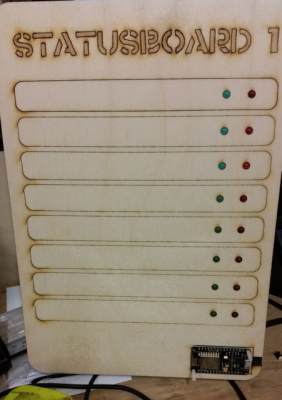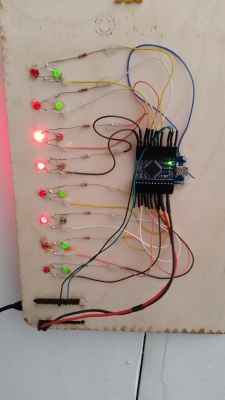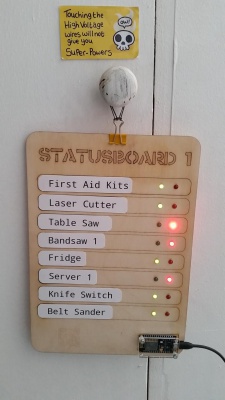Status Boards: Difference between revisions
mNo edit summary |
|||
| (10 intermediate revisions by 2 users not shown) | |||
| Line 2: | Line 2: | ||
[[Category:Projects (in progress)]] | [[Category:Projects (in progress)]] | ||
[[Category:Michael's Projects]] | [[Category:Michael's Projects]] | ||
__FORCETOC__ | |||
{{Project | |||
|name=Status Boards | |||
|primary=[[User:Msemtd|Michael Erskine]] | |||
|created=11/03/2016 | |||
|type=infrastructure | |||
}} | |||
Simple means of showing status of Hackspace stuff on web and physical boards. | Simple means of showing status of Hackspace stuff on web and physical boards. | ||
* NodeMCU ( | = Basic Project Plan = | ||
* NodeMCU (ESP8266) with Arduino core for WiFi-enabled status board | |||
* NodeJS server for HTTP access | * NodeJS server for HTTP access | ||
* a good starter project for the [[NodeMCU_v2]] | * a good starter project for the [[NodeMCU_v2]] and [[ESP8266]] | ||
* open source software on GitHub https://github.com/msemtd/nodemcu-statusboard | * open source software on GitHub https://github.com/msemtd/nodemcu-statusboard | ||
<gallery widths=400px heights=400px perrow=3 caption="Physical Prototype"> | <gallery widths=400px heights=400px perrow=3 caption="Physical Prototype"> | ||
File:Node-status-board-a4-1.png|First A4 lasercut prototype with 8 bits of data | File:Node-status-board-a4-1.png|First A4 lasercut prototype with 8 bits of data | ||
File:Status-board1-_2016-04-02_16.52.34.jpg|prototype back showing ProMicro and wiring | |||
File:Status-board-1-2016-04-02_16.39.20.jpg|functional prototype running with sample data | |||
</gallery> | </gallery> | ||
| Line 18: | Line 31: | ||
== Using a cheap ProMicro for I/O == | == Using a cheap ProMicro for I/O == | ||
The NodeMCU can tell the ProMicro what outputs to drive with a simple serial protocol: - | The NodeMCU can tell the [[ATMEGA32U4|ProMicro]] what outputs to drive with a simple serial protocol: - | ||
* ASCII for human convenience and same parsing code on both micros | * ASCII for human convenience and same parsing code on both micros | ||
* same interface on both UARTS - USB and HW for simplicity and testing | * same interface on both UARTS - USB and HW for simplicity and testing | ||
* The ESP8266-E is not 5v tolerant on the UART so I shall use a voltage divider | * The ESP8266-E is not 5v tolerant on the UART so I shall use a voltage divider | ||
** https://cdn-shop.adafruit.com/product-files/2471/0A-ESP8266__Datasheet__EN_v4.3.pdf | ** https://cdn-shop.adafruit.com/product-files/2471/0A-ESP8266__Datasheet__EN_v4.3.pdf | ||
== Power Profile == | |||
For my first tests I used a cheap 18650 power bank that one would normally use for recharging a mobile phone when off grid. It ran for less than 24hrs but I was not sure of the initial charge. Anyhow, there's no overarching need for this device to be battery powered so I will probably just run it from a spare mains phone charger but it has got me thinking about the power usage so I'm going to learn a little about that:- | |||
* I'd like a generic current logger that I can attach to various devices - e.g. the SparkFun Low Current Sensor Breakout - ACS712 https://www.sparkfun.com/products/8883 | |||
* there may be ways of reducing the current draw for the LEDs | |||
* The NodeMCU - is it a power hog? | |||
* how efficient is our 5v ProMicro and can we save power by making simple mods and running it at 3.3v | |||
= Real Data = | |||
The various readings need to come from the Hackspace infrastructure. These can be exposed to the local network if we only want status board units to run in the space, but since there's little difference between a public human-readable web interface and the simple ASCII interface used by the NodeMCU, it may as well be a feature of our public facing web. | |||
= Simple NodeJS Server = | |||
The nodeboard directory (https://github.com/msemtd/nodemcu-statusboard/tree/master/nodeboard) contains a simple NodeJS webserver that dishes up board data cached in memory. | |||
* it uses the minimalist expressjs web framework (see http://expressjs.com/) | |||
* At startup it reads boards.json that defines the various status boards, the field labels, and the saved byte values | |||
* A human visitor would request URL http://server:port/sb/1/ to see a HTML representation of board 1 | |||
* A NodeMCU would request URL http://server:port/sb/1/nodemcu to get a plain text string with the hex value for board 1 | |||
* There is a simple GET that will set the byte values of a board - this is an insecure example! | |||
** in reality we would be looking to authenticate users in secure manner (see http://passportjs.org/) | |||
* each board should be uniquely identified - most obvious would be to use the MAC address and embed this in the GET request header perhaps | |||
* each board uptime would also be useful - they could send GET queries at startup and every 20 minutes or so | |||
* each board could query its settings from the server | |||
* the server should track hits from individual boards - this info should be downloadable and chartable | |||
Latest revision as of 22:11, 2 December 2020
| Status Boards | |
|---|---|
| Primary Contact | Michael Erskine |
| Created | 11/03/2016 |
| Type | Hackspace Infrastructure |
Simple means of showing status of Hackspace stuff on web and physical boards.
Basic Project Plan
- NodeMCU (ESP8266) with Arduino core for WiFi-enabled status board
- NodeJS server for HTTP access
- a good starter project for the NodeMCU_v2 and ESP8266
- open source software on GitHub https://github.com/msemtd/nodemcu-statusboard
- Physical Prototype
-
First A4 lasercut prototype with 8 bits of data
-
prototype back showing ProMicro and wiring
-
functional prototype running with sample data
The driving of the 16 LEDs poses an interesting problem due to the limited number of digital outputs on the NodeMCU: we are looking for a simple low-cost solution so after looking at various ICs to perform the task I decided to throw in another inexpensive micro with plenty of I/O and control it with I2C, serial or similar.
Using a cheap ProMicro for I/O
The NodeMCU can tell the ProMicro what outputs to drive with a simple serial protocol: -
- ASCII for human convenience and same parsing code on both micros
- same interface on both UARTS - USB and HW for simplicity and testing
- The ESP8266-E is not 5v tolerant on the UART so I shall use a voltage divider
Power Profile
For my first tests I used a cheap 18650 power bank that one would normally use for recharging a mobile phone when off grid. It ran for less than 24hrs but I was not sure of the initial charge. Anyhow, there's no overarching need for this device to be battery powered so I will probably just run it from a spare mains phone charger but it has got me thinking about the power usage so I'm going to learn a little about that:-
- I'd like a generic current logger that I can attach to various devices - e.g. the SparkFun Low Current Sensor Breakout - ACS712 https://www.sparkfun.com/products/8883
- there may be ways of reducing the current draw for the LEDs
- The NodeMCU - is it a power hog?
- how efficient is our 5v ProMicro and can we save power by making simple mods and running it at 3.3v
Real Data
The various readings need to come from the Hackspace infrastructure. These can be exposed to the local network if we only want status board units to run in the space, but since there's little difference between a public human-readable web interface and the simple ASCII interface used by the NodeMCU, it may as well be a feature of our public facing web.
Simple NodeJS Server
The nodeboard directory (https://github.com/msemtd/nodemcu-statusboard/tree/master/nodeboard) contains a simple NodeJS webserver that dishes up board data cached in memory.
- it uses the minimalist expressjs web framework (see http://expressjs.com/)
- At startup it reads boards.json that defines the various status boards, the field labels, and the saved byte values
- A human visitor would request URL http://server:port/sb/1/ to see a HTML representation of board 1
- A NodeMCU would request URL http://server:port/sb/1/nodemcu to get a plain text string with the hex value for board 1
- There is a simple GET that will set the byte values of a board - this is an insecure example!
- in reality we would be looking to authenticate users in secure manner (see http://passportjs.org/)
- each board should be uniquely identified - most obvious would be to use the MAC address and embed this in the GET request header perhaps
- each board uptime would also be useful - they could send GET queries at startup and every 20 minutes or so
- each board could query its settings from the server
- the server should track hits from individual boards - this info should be downloadable and chartable


